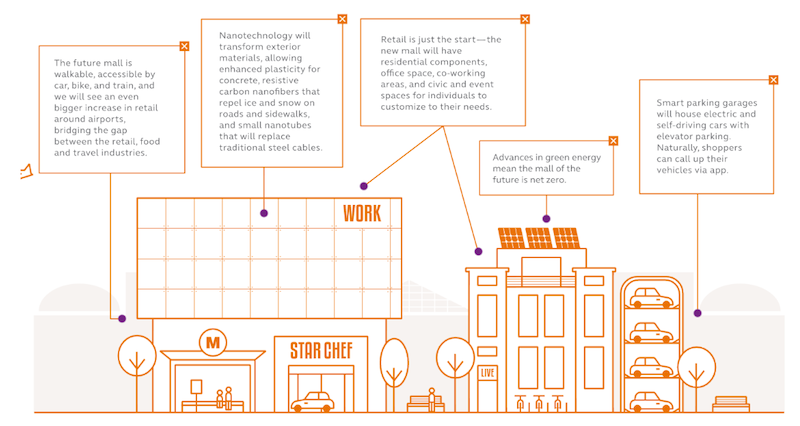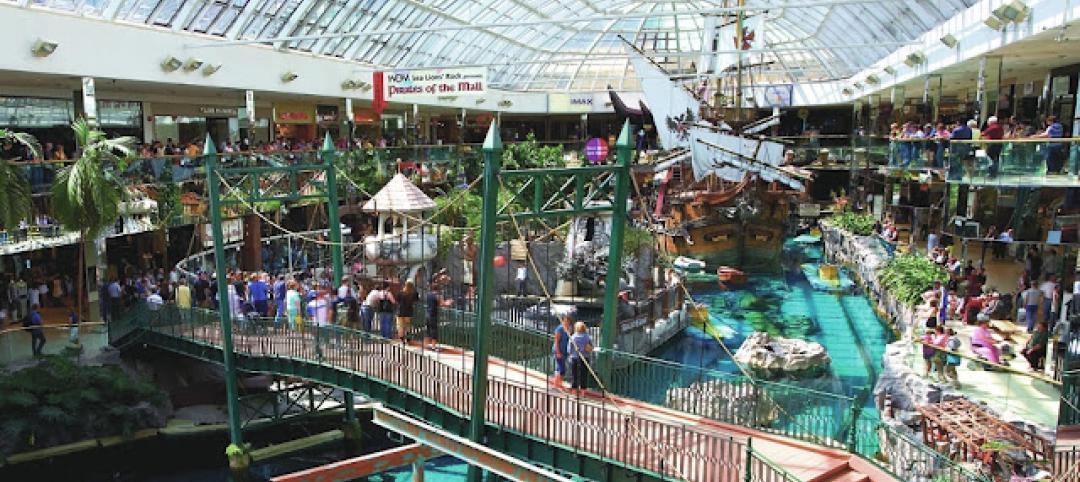The shopping mall of tomorrow will be more like a community center, with access to mass transit, offices, apartments, museums, and services like childcare. Already, some malls have become micro cities that are “changing the face of American retail,” according to CallisonRTKL in its “Mall of the Future,” a compendium of ideas and design trends that the firm believes could drive where shopping malls and retail will be heading over the next two decades.
The firm’s portfolio includes some of the world’s largest and most complex retail malls, so it’s not surprising that CallisonRTKL foresees shopping centers as focal points of urbanized living. Indeed, the firm all but predicts that malls that don’t move in this direction are in danger of becoming extinct at a time when at least one-third of the 1,200 retail malls in the U.S. are on death’s doorstep, and customer expectations about their shopping experiences are rapidly evolving.
'Design wise, malls will require twice the common area of typical malls we see today.'
For one thing, customers want to get out of their cars. CallisonRTKL’s report cites research from the Urban Land Institute, which finds a strong preference among all adult age groups to live in or near mixed-use, walkable neighborhoods.
More broadly, the new generation of shopper is seeking new experiences, not just waiting for them. Retail centers must be flexible in their spaces and assortments to continually offer enough variety that can drive customer traffic. Citing research from Medallia Analysis, CallisonRTKL points out that satisfied customers spend, on average, 140% more than people who are less satisfied with their shopping experiences.
Despite double-digit growth in online shopping in recent years, CallisonRTKL remains bullish on bricks-and-mortar shopping centers.
One of their major competitive responses to online shopping’s encroachment has been food: CallisonRTKL notes that for the first time ever, Americans in 2015 spent more money on dining out than on buying groceries. So malls are adding higher-end restaurants that feature local cuisine. More retail centers are giving customers the option of ordering food online and picking it up at the mall. Some centers have even programmed space for farmers’ markets and community gardens.
Technology is transforming the mall environment. It is unleashing areas used for warehouse space for “click and collect” products and same-day delivery of online sales. More malls are installing interactive maps and wayfinding signage. The Internet of Things is helping retailers market directly and instantaneously to wired shoppers via their smartphones.
 Shopping will just be one facet of tomorrow's successful malls, which will tap into customers' desire to live in walkable, greener communities. Image: CallisonRTKL's “Mall of the Future” report
Shopping will just be one facet of tomorrow's successful malls, which will tap into customers' desire to live in walkable, greener communities. Image: CallisonRTKL's “Mall of the Future” report
CallisonRTKL expects all of these trends to become more widely applied in the malls of tomorrow. The firm foresees walkable malls accessible by public transit or bicycles. Malls will include residential, office, civic, and event spaces. They will be powered by renewable energy. Smart parking garages will accommodate electric cards, and driver apps. The firm also expects more malls to be built near airports, “bridging the gap between retail, food, and travel industries.”
Technology will seep into every aspect of a mall’s design, construction, and operations. “It’s not about gadgets; it’s about infrastructure,” CallisonRTKL wrote. Nanotechnology will help develop better, more durable building products with smaller carbon footprints. Click and collect “will remain and must,” and be much quicker. Broader and better connectivity will provide a customized shopping experience. Stores will include interactive fitting suites that allow customers to digitally try on products before ordering them online. Stores will stock less, and use extra space for warehousing inventory for same-day drone delivery.
Rooftops of malls will be employed for entertainment, dining, and gardens, and be “greener” by reducing heat transmission and water runoff. Customers will use apps to have food and goods delivered anywhere, with alerts for when the pickup is ready and where. Robot delivery will be an option for some malls.
Food will anchor the retail experience, in the forms of restaurants, farms, pop-up vendors, specialty stores, and food festivals. Some of these could be programmed to change daily.
CallisonRTKL goes so far as to suggest that some malls might allow diners the option of growing their own dinners from onsite vegetable gardens and urban beehives. At the very least, successful malls will have pop-up infrastructures that are anchored by preset retail common areas. “Design wise, malls will require twice the common area of typical malls we see today.”
CallisonRTKL foresees more consumers actively seeking shopping experiences that align with their environmentalist inclinations. Streamlined sourcing labels, more dependable vetting processes, and increased connectivity will make it easier for shoppers to choose retailers and products that have a positive effect. “This is a consumer-driven movement that is only going to grow stronger in the next few years.”
Related Stories
| Feb 8, 2012
Mega-malls expanding internationally
Historically, malls have always been the icons of America – the first mall ever was built in Minneapolis in 1956.
| Jan 15, 2012
Smith Consulting Architects designs Flower Hill Promenade expansion in Del Mar, Calif.
The $22 million expansion includes a 75,000-square-foot, two-story retail/office building and a 397-car parking structure, along with parking and circulation improvements and new landscaping throughout.
| Jan 6, 2012
New Walgreen's represents an architectural departure
The structure's exterior is a major departure from the corporate image of a traditional Walgreens design.
| Jan 6, 2012
Summit Design+Build completes Park Place in Illinois
Summit was responsible for the complete gut and renovation of the former auto repair shop which required the partial demolition of the existing building, while maintaining the integrity of the original 100 year-old structure, and significant re-grading and landscaping of the site.
| Nov 29, 2011
Suffolk Construction breaks ground on Boston residential tower
Millennium Place III is a $220 million, 256-unit development that will occupy a full city block in Boston’s Downtown Crossing.
| Nov 29, 2011
Report finds credit crunch accounts for 20% of nation’s stalled projects
Persistent financing crunch continues to plague design and construction sector.
| Nov 22, 2011
Jones Lang LaSalle completes construction of two new stores in Manhattan
Firm creates new global design standard serving as project manager for Uniglo’s 89,000-sf flagship location and, 64,000-sf store.
| Oct 26, 2011
Shawmut Design and Construction awarded Tag Heuer build in Aventura, Fla.
New store features 1,200 sf fit out at Aventura Mall.
| Oct 3, 2011
Magellan Development Group opens Village Market in Chicago’s Lakeshore East neighborhood
Magellan Development Group and Hanwha Engineering & Construction are joint-venture development partners on the project. The Village Market was designed for Silver LEED certification by Loewenberg Architects and built by McHugh Construction.















